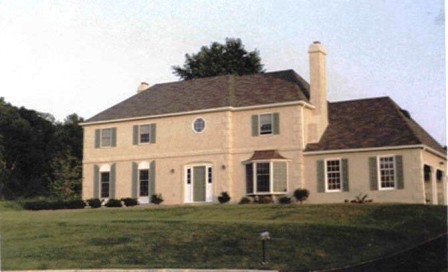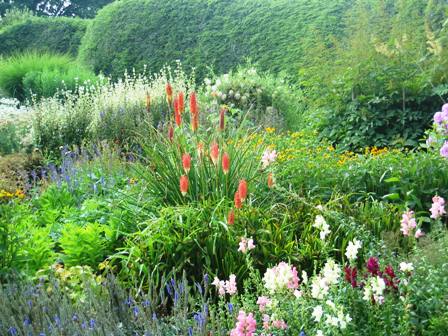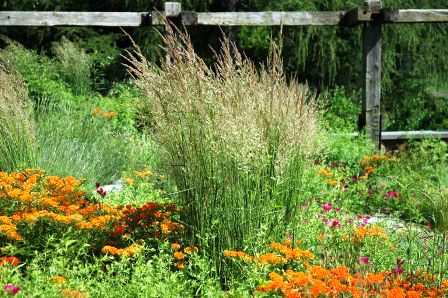Having worked on the same piece of land, a steeply sloping and oddly shaped one half acre lot for a quarter of a century (which I am in the process of selling), I have a made a multitude of mistakes and experienced enough ‘ah ha’ moments that the joy of digging, observing and connecting to nature has never ceased to amaze me.
Here are some of the lessons I’ve learned in observing the transformation of my landscape over this extended period of time.
1. GET IN TOUCH WITH YOUR IMAGINATION. To imagine is to see possibilities, to see realities that don’t yet exist. In our technologically oriented society, little emphasis is placed on giving ourselves the time to let our minds wander. And yes, this is true for gardeners as much as it is for other folks who work at ‘indoor’ jobs. We all have an imagination. It is a significant part of our souls. For so many of us, it is submerged deep down inside. But it’s there for the taking, if you desire. How do you access it? I find that taking solitary nature walks with no agenda, where I allow my mind to relax and explore, to romp about in its own playground away from the constraints of daily life, begins to loosen the self imposed chains. Often after taking a walk, I will come indoors and quickly write down any thoughts that have come to mind.
I also use any childhood memories of sights, smells and sounds of nature to help conjure up yearnings below the surface. This spring, observing germinated seeds jump start into seedlings has given me a bit more ‘pep to my step’ and has actually stoked some creative juices within me. There is no one way to access your imagination. For you, it might be playing a musical instrument, listening to music, going for an invigorating run outside or working on a research project. But once you discover the plethora of fertile ideas within your own psyche, you’ll be surprised at the original thoughts that erupt from your unconscious into your conscious mind.
2.VIEW YOUR FRONT YARD AS AN OPPORTUNITY TO CREATE A GARDEN ROOM. Most Americans still think that front yards should look a certain way: lined up with a slew of evergreens, along with some deciduous shrubs, trees and perhaps a smattering of ornamental grassses. Pretty staid, isn’t it? I will never forget the first time that I went to Stratford-Upon-Avon in England and visited Anne Hathway’s home. It was a lovely tudor with a winding front walkway. But what grabbed my heartstrings most was the intensely planted front yard cottage garden. The time I spent in this garden left a significant imprint on my psyche. For the first time, I realized that a front yard had the ability to be created into a glorious garden room of its own. Over several years and even more reincarnations, I finally created a front yard garden of my dreams: a romantic, heirloom rose/ perennial garden (as discussed in an earlier post). It has a gently winding pathway that leads to other garden on either side of the house, is dotted with native junipers, boxwoods and rows of yews plus rose arches to offer structure: the remainder of the garden is a mix of perennials, tubers, bulbs and annuals. People are absolutely blown away when they begin to walk through this meandering gatrden and realize that they are indeed in a garden room.
3. EXPERIMENT WITH PLACEMENT OF PLANTS. The rule of thumb that tall plants should be placed in the back of a mixed border with the shorter ones in the front and the mid-sized ones sandwiched in between may make sense most of the time but should not be treated as an iron clad rule. Some of my greatest plant placements have taken place when I let my inspiration take precedent over the ‘rules’. If a tall plant is light and airy, it can make a great exclamation point placed towards the front or middle of the border. I often place a large plant such as Crambe cordifolia towards the front of the border so that the the aroma of its delicate white flowers literally touches a visitor as she passes by. Other ‘overscaled’ plants that I intermittently plop down in the front of my borders are: agaves, yuccas, euphorbias, agastaches, phormiums, cannas, alocasias and dahlias. Their exotic leaves and/or flowers lend themselves to wanting to be stand outs in garden borders. I do the same with certain grasses like: Molinia ‘Windspiel’ or Panicum virgatum. The rhythm of the garden design can be broken up by placing these plants towards the front of the border: it jolts the eye and keeps things fresh and ‘in your face’. A little repositioning of plants goes a long way.
4. THINK OF THE LIMITATIONS OF YOUR GARDEN AS AN ASSET RATHER THAN A LIABILITY. This is a tough lesson to learn but one that is critical for joyful gardening and for living a creative and fulfilling life. So many of us have been raised with a passive attitude of ‘wishfulness’: “If only I had” or “When I become”. Embrace what property or place you live in now! Don’t wait until you purchase a perfect piece of land before you let your soul soar with imagination. It doesn’t matter where you live, whether it be a small row house, condominium, apartment window sill, deck, steeply sloping lot or acres of land. If you have desire and a great passion to garden, you will find a way to bring a garden into your life. I am convinced that it is in part because I have gardened all of these years on what many would consider to be a difficult piece of land in a typical suburban development that my garden has developed into what it has become: a tightly planted, feisty, exuberant garden. In order to move forward, I eventually faced up to the limitations of what my property and surroundings were and then began to work with and through those limitations (kind of like working through a close relationship with another human being).
Our gardens do mirror our souls and the way we live. So, take ownership of and embrace your property: then let the creative process begin. If you persist at trying to find different solutions on how best to design and plant it, remain flexible and not rush to judgment in your decision making process, are willing to be an independent thinker and resist the need to design within ‘the box’, you will have a great opportunity to turn your piece of land into a little jewel. Often in life what we consider to be our greatest liabilities end up being our greatest strengths.




